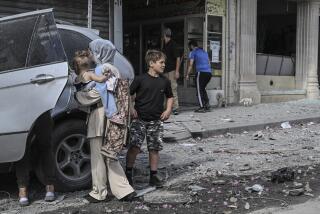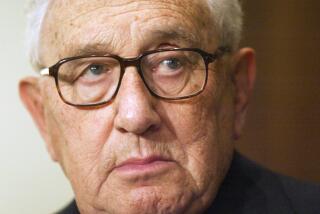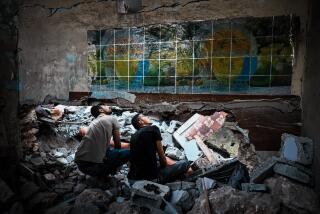A Regime Living Amid Its Ghosts
- Share via
WASHINGTON — If there is a place condemned to repeat history, it may well be Pakistan. This year, Pakistanis have good reason to approach the second anniversary of Gen. Pervez Musharraf’s coup with apprehension. As a U.S.-led coalition prepares to strike at global terrorism and sets its sights on the Taliban, it should read recent Pakistani history with care and ensure that sorting out Afghanistan does not again leave Pakistanis out in the cold.
When the Soviet army marched into Afghanistan in the waning days of 1979, the world had virtually lost patience with Pakistan. Gen. Mohammed Zia ul-Haq had seized power in July 1977 from Prime Minister Zulfikar Ali Bhutto, whose lust for power, regional meddling, authoritarian habits and nuclear ambitions had consigned him to the outer reaches of U.S. foreign policy. But two years later, Zia’s repressive habits, and his execution of Bhutto, had strained Pakistan’s relations not only with the West, but also with his backers in the Muslim world.
Moscow’s incursion into Afghanistan changed everything. Soviet Premier Leonid I. Brezhnev’s “Christmas gift” to Zia, as local commentators dubbed the ensuing Afghan war, resulted in an international campaign to bring down the Soviet Union. Pakistan became the staging ground for a complex network of armed Afghan exile groups and foreign fighters who helped transform a local conflict into a global campaign to change the face of governance in the region. At home, Zia used the Afghan war to justify the wholesale denial of civil liberties to Pakistanis who opposed his rule, to prop up Islamist parties and fringe groups to create the appearance of popular support for dictatorship, and to solidify the military’s hold on the country’s domestic and foreign policies.
When Zia took power, Pakistan was burdened by the combined weight of Iran, then consumed by the hostage crisis and its own Islamic revolution, and India, which was on at the cusp of economic reform. In response, Zia changed Pakistan. With a handful of ordinances and regulations, he rewrote Pakistan’s political script, stripping secularists of their constitutional rights and setting the stage for a foreign policy that blended militancy and military might. Although his regime ultimately imploded--felled as much by its own weight as by Zia’s death--his civilian successors never got a handle on the army and, worse, couldn’t grasp control of the state.
Fast-forward to 2001. The parallels are eerie. Musharraf appropriated power Oct. 12, 1999, overturning the weak-limbed, intermittently cruel, corrupt and nuclear-minded government of Prime Minister Nawaz Sharif. Sharif followed Zia’s chief tenet: Might makes right, even when it’s dead wrong. But his nuclear testing in 1998 wasn’t bellicose enough for Pakistan’s army. Musharraf, the army chief, wanted decisive victory in Pakistan’s continuing struggle for Kashmir and a clear say in Afghanistan’s conflicts, and he toppled a civilian regime to try to achieve both.
But Musharraf couldn’t pull off the promise of his coup. The Kashmir engagement and Afghanistan’s war drag on, captive to extremists who have compromised South Asia’s security and to terrorists who have endangered the rest of the world. It didn’t take long for the international community to dispense with Musharraf, leaving Pakistanis to cope with a contorted politics, vanishing civil rights, rising sectarian conflict, looming military debt and the terrors of isolation in an increasingly global economy. But for the Sept. 11 terrorist attacks in New York and Washington, the pendulum of Pakistani politics might well have swung away from Musharraf.
Once again, international actors are likely to influence Pakistan’s political choices. When Soviet troops arrived in Afghanistan, the U.S. appeared at the Khyber Pass to pledge arms for Afghans. Zia turned that vow into a U.S. commitment to sustain military rule in Pakistan for eight more years, and U.S. policy followed the Cold War playbook.
This wasn’t inevitable. The U.S. could have contained Afghanistan’s civil conflict rather than wage an enormous proxy war. It could have treated Pakistanis--as distinct from their oppressive government--as allies rather than as pawns in a struggle against a distant enemy. When the Soviet army marched home in 1989, the U.S. could have stayed to rebuild Afghanistan rather than try to manipulate vestigial moujahedeen groups, and watch Afghanistan wither away. And it could have reinforced the small stirrings of democracy in Pakistan, instead of turning away from the hard work of stabilizing a Cold War-weary state.
Pakistanis link their domestic historical markers--coups, wars and occasional elections--to the beginning, middle and incomplete end of the Cold War. Threaded among these events is Pakistan’s roller-coaster relationship with the United States, and the sad fragilities that military alliances have imposed on Pakistani civil society.
Neither the U.S. nor Pakistan need repeat its mistakes. Pakistan has everything to gain from fighting terrorism at home and among its neighbors. To rid their landscape of extremism, however, Pakistanis need the same rights protections that Americans claim--and they need to know that when the U.S. makes deals with the military, it also stands for the promises of democracy.
The United States and its allies are preparing to do business with all manner of governments and fighting factions across South and Central Asia. Hoping to unseat extremists, they can easily fall prey to the same false policy distinctions between security and rights that weakened countries like Pakistan and created conditions of profound instability. Guarding against easy answers is the only insurance against backlash, blowback and reinforced belligerence. Otherwise, the new century’s background noise will be the sound of history repeating itself in Pakistan.
More to Read
Sign up for Essential California
The most important California stories and recommendations in your inbox every morning.
You may occasionally receive promotional content from the Los Angeles Times.













